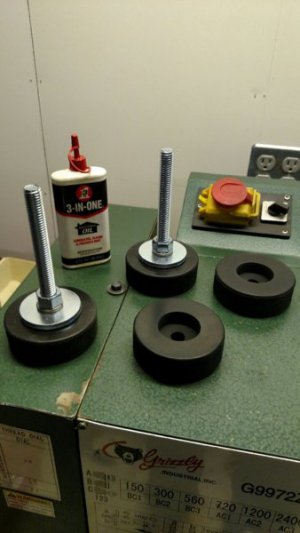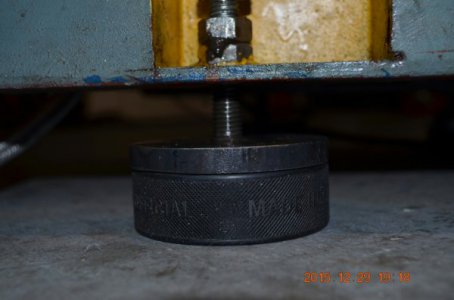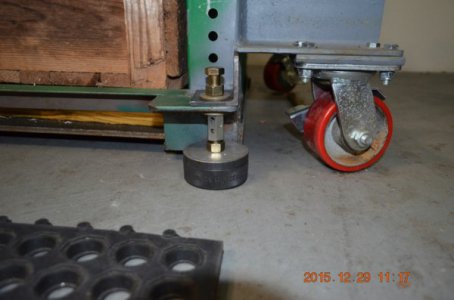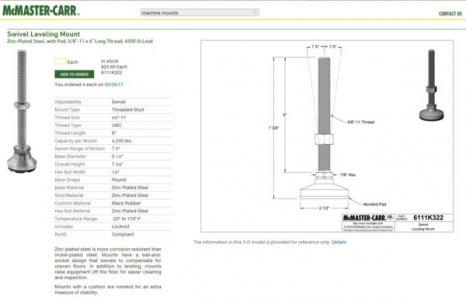...but little analysis.
Yes, I've seen many examples of hockey puck machine mounts, and I've seen the Youtube video of the guy crushing a hockey puck with an 82,000lb hydraulic press.
It would have been useful if he had used slow motion with a force gauge inset in the video!
I'd like to know the compressive load capacity of a hockey puck lying on it's face. The nominal
durometer of a puck is 90 Shore A harness.
I've made and used them before for my band saw and 12in disc sander, much lighter machines. See below.

I want to raise my Series1 Bridgeport milling machine about 3.5 inches off the floor to better accommodate my height, and to allow getting my pallet jack underneath for moving occasionally.
The weight of my Bridgeport, with 12inch knee, vise, work, and tooling is approximately 2400lbs.
If I put a hockey puck at each of the four corners of a frame under the Bridgeport, each puck needs to support better than 600lbs of static compressive force, not to mention dynamic forces.
By my calculation, each puck has 5.6 square inches of surface/contact area when you consider
the counter bore on the underside to accommodate the head of a bolt. This works out to about 108lbs compressive load per square inch.
Multiply this 5.6 square inches by the four pucks, you get 22 square inches total holding up my Bridgeport.
I'm using 5/8-11 nuts and bolts (grade 5 proof load is 19,000 lbs) to assure the threads won't strip, with
3 inch diameter thick washers on the top surface of the puck for good weight distribution.
My reinforced floor is smooth and flat except for a slight run-off slope, and intuitively I think it's all
going to work fine.
But I'd like to get a sense of how much the puck might "squish", due to these compressive forces, and if I might someday find my Bridgeport "copping a lean" due to a hockey puck "blow-out".
Objective insight gratefully received.
Yes, I've seen many examples of hockey puck machine mounts, and I've seen the Youtube video of the guy crushing a hockey puck with an 82,000lb hydraulic press.
It would have been useful if he had used slow motion with a force gauge inset in the video!
I'd like to know the compressive load capacity of a hockey puck lying on it's face. The nominal
durometer of a puck is 90 Shore A harness.
I've made and used them before for my band saw and 12in disc sander, much lighter machines. See below.

I want to raise my Series1 Bridgeport milling machine about 3.5 inches off the floor to better accommodate my height, and to allow getting my pallet jack underneath for moving occasionally.
The weight of my Bridgeport, with 12inch knee, vise, work, and tooling is approximately 2400lbs.
If I put a hockey puck at each of the four corners of a frame under the Bridgeport, each puck needs to support better than 600lbs of static compressive force, not to mention dynamic forces.
By my calculation, each puck has 5.6 square inches of surface/contact area when you consider
the counter bore on the underside to accommodate the head of a bolt. This works out to about 108lbs compressive load per square inch.
Multiply this 5.6 square inches by the four pucks, you get 22 square inches total holding up my Bridgeport.
I'm using 5/8-11 nuts and bolts (grade 5 proof load is 19,000 lbs) to assure the threads won't strip, with
3 inch diameter thick washers on the top surface of the puck for good weight distribution.
My reinforced floor is smooth and flat except for a slight run-off slope, and intuitively I think it's all
going to work fine.
But I'd like to get a sense of how much the puck might "squish", due to these compressive forces, and if I might someday find my Bridgeport "copping a lean" due to a hockey puck "blow-out".
Objective insight gratefully received.




